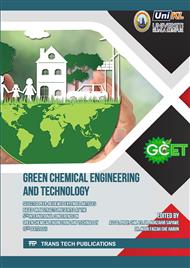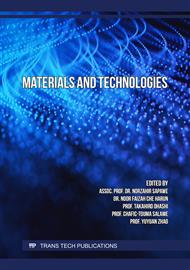[1]
Y. Bulut, H. J. J. o. d. s. Karaer, and technology, Adsorption of methylene blue from aqueous solution by crosslinked chitosan/bentonite composite,, vol. 36, no. 1, pp.61-67, (2015).
DOI: 10.1080/01932691.2014.888004
Google Scholar
[2]
T. Jing et al., Highly effective removal of 2, 4-dinitrophenolic from surface water and wastewater samples using hydrophilic molecularly imprinted polymers,, vol. 21, no. 2, pp.1153-1162, (2014).
DOI: 10.1007/s11356-013-2007-0
Google Scholar
[3]
G. Bayramoglu, B. Altintas, M. Y. J. J. o. C. T. Arica, and Biotechnology, Synthesis and characterization of magnetic beads containing aminated fibrous surfaces for removal of Reactive Green 19 dye: kinetics and thermodynamic parameters,, vol. 87, no. 5, pp.705-713, (2012).
DOI: 10.1002/jctb.3693
Google Scholar
[4]
B. Gao, X. Cha, T. Chen, and L. J. J. o. E. C. E. Fan, Designing and preparing of acid dye surface-imprinted material for effective removal of acid dyes from water,, vol. 3, no. 1, pp.277-285, (2015).
DOI: 10.1016/j.jece.2014.10.017
Google Scholar
[5]
Z. Carmen and S. Daniela, Textile organic dyes-characteristics, polluting effects and separation/elimination procedures from industrial effluents-a critical overview. IntechOpen Rijeka, (2012).
DOI: 10.5772/32373
Google Scholar
[6]
A. Anouzla, Y. Abrouki, S. Souabi, M. Safi, and H. J. J. o. H. M. Rhbal, Colour and COD removal of disperse dye solution by a novel coagulant: application of statistical design for the optimization and regression analysis,, vol. 166, no. 2-3, pp.1302-1306, (2009).
DOI: 10.1016/j.jhazmat.2008.12.039
Google Scholar
[7]
V. Kasperchik, A. Yaskevich, and A. J. P. C. Bil'Dyukevich, Wastewater treatment for removal of dyes by coagulation and membrane processes,, vol. 52, no. 7, pp.545-556, (2012).
DOI: 10.1134/s0965544112070079
Google Scholar
[8]
B. K. Körbahti, K. Artut, C. Geçgel, and A. J. C. E. J. Özer, Electrochemical decolorization of textile dyes and removal of metal ions from textile dye and metal ion binary mixtures,, vol. 173, no. 3, pp.677-688, (2011).
DOI: 10.1016/j.cej.2011.02.018
Google Scholar
[9]
C. Sahunin, J. Kaewboran, and M. J. r. Hunsom, Treatment of textile dyeing wastewater by photo oxidation using UV/H,, vol. 22, p.23, (2006).
Google Scholar
[10]
S. J. E. E. S. Mondal, Methods of dye removal from dye house effluent—an overview,, vol. 25, no. 3, pp.383-396, (2008).
DOI: 10.1089/ees.2007.0049
Google Scholar
[11]
C.-H. Tsai, W.-C. Chang, D. Saikia, C.-E. Wu, and H.-M. J. J. o. h. m. Kao, Functionalization of cubic mesoporous silica SBA-16 with carboxylic acid via one-pot synthesis route for effective removal of cationic dyes,, vol. 309, pp.236-248, (2016).
DOI: 10.1016/j.jhazmat.2015.08.051
Google Scholar
[12]
T. Ataei-Germi, A. J. J. o. c. Nematollahzadeh, and i. science, Bimodal porous silica microspheres decorated with polydopamine nano-particles for the adsorption of methylene blue in fixed-bed columns,, vol. 470, pp.172-182, (2016).
DOI: 10.1016/j.jcis.2016.02.057
Google Scholar
[13]
N. Saman, N. A. A. Kamal, J. W. P. Lye, and H. J. A. P. T. Mat, Synthesis and characterization of CTAB-silica nanocapsules and its adsorption behavior towards Pd (II) ions in aqueous solution,, vol. 31, no. 8, pp.3205-3214, (2020).
DOI: 10.1016/j.apt.2020.06.007
Google Scholar
[14]
K. Choi et al., Chromium removal from aqueous solution by a PEI-silica nanocomposite,, vol. 8, no. 1, pp.1-10, (2018).
Google Scholar
[15]
L. Bois et al., Functionalized silica for heavy metal ions adsorption,, vol. 221, no. 1-3, pp.221-230, (2003).
Google Scholar
[16]
M. Anbia, S. A. Hariri, and S. J. A. S. S. Ashrafizadeh, Adsorptive removal of anionic dyes by modified nanoporous silica SBA-3,, vol. 256, no. 10, pp.3228-3233, (2010).
DOI: 10.1016/j.apsusc.2009.12.010
Google Scholar
[17]
S. Schlichter, K. Sapag, M. Dennehy, and M. J. J. o. e. c. e. Alvarez, Metal-based mesoporous materials and their application as catalysts for the degradation of methyl orange azo dye,, vol. 5, no. 5, pp.5207-5214, (2017).
DOI: 10.1016/j.jece.2017.09.039
Google Scholar
[18]
S. Asuha, X. Zhou, and S. J. J. o. h. m. Zhao, Adsorption of methyl orange and Cr (VI) on mesoporous TiO2 prepared by hydrothermal method,, vol. 181, no. 1-3, pp.204-210, (2010).
DOI: 10.1016/j.jhazmat.2010.04.117
Google Scholar
[19]
B. S. Rathore, N. P. S. Chauhan, M. K. Rawal, S. C. Ameta, and R. J. P. B. Ameta, Chitosan–polyaniline–copper (II) oxide hybrid composite for the removal of methyl orange dye,, vol. 77, no. 9, pp.4833-4850, (2020).
DOI: 10.1007/s00289-019-02994-7
Google Scholar
[20]
L. Wang et al., Stable organic–inorganic hybrid of polyaniline/α-zirconium phosphate for efficient removal of organic pollutants in water environment,, vol. 4, no. 5, pp.2686-2692, (2012).
DOI: 10.1021/am300335e
Google Scholar
[21]
Y.-S. J. J. o. h. m. Ho, Review of second-order models for adsorption systems,, vol. 136, no. 3, pp.681-689, (2006).
Google Scholar
[22]
A. S. Dhmees, N. M. Khaleel, and S. A. J. E. j. o. p. Mahmoud, Synthesis of silica nanoparticles from blast furnace slag as cost-effective adsorbent for efficient azo-dye removal,, vol. 27, no. 4, pp.1113-1121, (2018).
DOI: 10.1016/j.ejpe.2018.03.012
Google Scholar
[23]
H. S. Jamwal, S. Kumari, G. S. Chauhan, N. Reddy, and J.-H. J. J. o. e. c. e. Ahn, Silica-polymer hybrid materials as methylene blue adsorbents,, vol. 5, no. 1, pp.103-113, (2017).
DOI: 10.1016/j.jece.2016.11.029
Google Scholar
[24]
M. Mirzaie, A. Rashidi, H.-A. Tayebi, M. E. J. J. o. C. Yazdanshenas, and E. Data, Removal of anionic dye from aqueous media by adsorption onto SBA-15/polyamidoamine dendrimer hybrid: adsorption equilibrium and kinetics,, vol. 62, no. 4, pp.1365-1376, (2017).
DOI: 10.1021/acs.jced.6b00917
Google Scholar
[25]
W. J. Weber Jr and J. C. J. J. o. t. s. e. d. Morris, Kinetics of adsorption on carbon from solution,, vol. 89, no. 2, pp.31-59, (1963).
Google Scholar
[26]
L. Wang and A. J. J. o. h. m. Wang, Adsorption properties of Congo Red from aqueous solution onto surfactant-modified montmorillonite,, vol. 160, no. 1, pp.173-180, (2008).
DOI: 10.1016/j.jhazmat.2008.02.104
Google Scholar
[27]
K. G. Bhattacharyya and S. S. J. A. Gupta, Adsorption of Fe (III) from water by natural and acid activated clays: studies on equilibrium isotherm, kinetics and thermodynamics of interactions,, vol. 12, no. 3, pp.185-204, (2006).
DOI: 10.1007/s10450-006-0145-0
Google Scholar
[28]
K. Johari, N. Saman, S. Song, J. Heng, and H. J. C. E. C. Mat, Study of Hg (II) removal from aqueous solution using lignocellulosic coconut fiber biosorbents: equilibrium and kinetic evaluation,, vol. 201, no. 9, pp.1198-1220, (2014).
DOI: 10.1080/00986445.2013.806311
Google Scholar
[29]
A. Adamson, G. Boyd, and L. J. J. A. C. S. Myers, The exchange adsorption of ions from aqueous solutions by organic zeolites; kinetics,, vol. 69, no. 11, p.2836, (1947).
DOI: 10.1021/ja01203a066
Google Scholar
[30]
M. Toor and B. J. C. E. J. Jin, Adsorption characteristics, isotherm, kinetics, and diffusion of modified natural bentonite for removing diazo dye,, vol. 187, pp.79-88, (2012).
DOI: 10.1016/j.cej.2012.01.089
Google Scholar



